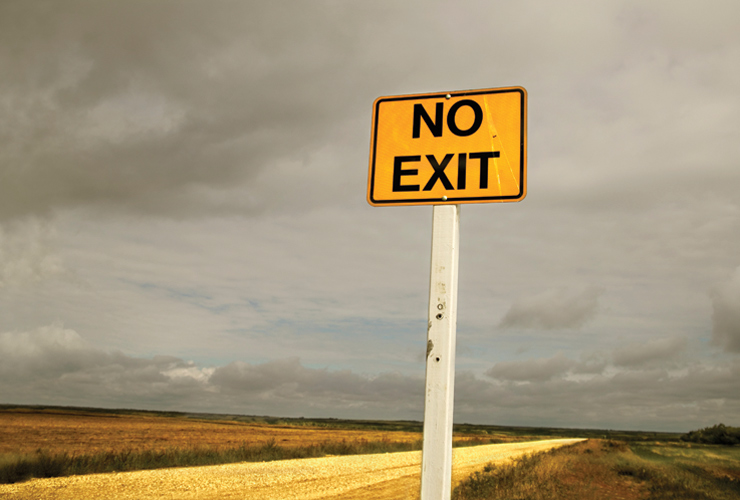 Mental health research suggests that loss is a risk for suicide attempt and completion.
Mental health research suggests that loss is a risk for suicide attempt and completion.
Sudden loss, such as that brought about by the diagnosis of a terminal illness or threat of incarceration, can increase risk for suicide in vulnerable individuals. So can loss sustained over time, such as from a farm that is failing.
Then it makes sense that those living in rural and remote regions, while embracing quiet country life, also shoulder bleak aspects of sparse rural living, many loss-related, that can impact mental well-being.
The numbers tell the story. Suicide is the second leading cause of death in states with primarily rural populations, especially in states in the rural mountain west and Alaska. Suicide rates in rural areas consistently surpass those of urban areas in America. From 1970 to 1997, the incidence of suicide among males in rural areas was 37 percent higher than urban areas – 27 per 100,000 versus 17 per 100,000. Suicide rates for Native Americans range from 1.5 to over 3 times the national average for other groups.
Youths are disproportionately affected with a rate 2.5 times higher than the national average for Indian youths ages 15 – 24. Nearly three-fourths of rural counties in America lack a psychiatrist, and 95 percent lack a child psychiatrist. Among small counties with less than 2500 population, one-third have no health professional able to address mental health needs.
“The services just aren’t there. In urban areas you might have a caseworker assisting a suicidal person. In rural areas sometimes the best ‘mental health’ services you get are from a police officer or school counselor,” says Christian Hanna, MPH, who works in rural and agricultural health and safety at the Marshfield Clinic Research Foundation in Marshfield, Wis. Hanna works with states nationwide to boost suicide prevention efforts. “Rural populations are underserved for mental health; there are gross inequities for distribution of mental health services.”
Sparse services, stigma are contributors
Since the 1950s rural suicide rates have outpaced those in urban areas. But, in recent years, this gap is widening as suicide rates decline in some urban areas, but increase in rural America.
“Rural has a lot of significant disparities. Over 90 percent of psychiatrists practice in urban and suburban areas,” notes Dennis Mohatt of the gross shortage of skilled professionals in rural America to treat those with mental illnesses and suicidal behaviors. Mohatt is director of the mental health program at WICHE, the Western Interstate Commission for Higher Education.
When mental health specialists are available, they don’t often last long in rural areas.
“It’s a matter of economics, of social choice and more modest insurance. There’s a depressed insurance marketplace for professionals to draw on,” adds Mohatt of inadequate insurance coverage for mental health in rural America. “The economics of it are you don’t make any money.”
Poverty, geographical isolation and cultural differences can further remove rural populations from services they need. When people do seek care, oftentimes their symptoms are more serious and their illnesses have progressed, thus requiring more intensive and expensive treatment. Moreover, some rural residents raised in stoic and self-reliant cultures resist seeking mental health treatment – no matter how despondent they are.
“There’s a stigma. These are strong, independent people who think they don’t really need help from anyone else,” continues Hanna with the Marshfield Clinic. Lack of confidentiality and anonymity in close-knit communities doesn’t help when someone is struggling with mental illness or thoughts of suicide.
“Stigma is more of an issue in rural, more traditional areas than in more urban areas,” says Lloyd Potter, PhD, former director of the federally funded Suicide Prevention Resource Center. “If you park your car in front of a psychotherapists’s office in a small town, people are going to know.”
Stigma may also affect reporting of cause of death by coroners in rural areas. In these close communities, coroners may bow to wishes of grieving families who ask that their loved one’s death be listed as accidental or undetermined, not as suicide. Hanna estimates that up to half of suicides go unreported as such. This underreporting leads to lack of accurate surveillance for suicide. The changing face of rural America also stresses its residents.
“Thirty years ago, you sat in the same desk at school that your parents did,” Hanna says. “Today towns of 600 are becoming towns of 1200. That rapid growth affects the stability of small towns. There are disjointed or no services as new people move into town.”
Easy access to lethal means is also a factor in high rates of self-inflicted death in rural areas. “A child could do something, and a mile away neighbors wouldn’t hear the gunshot,” Hanna adds.

